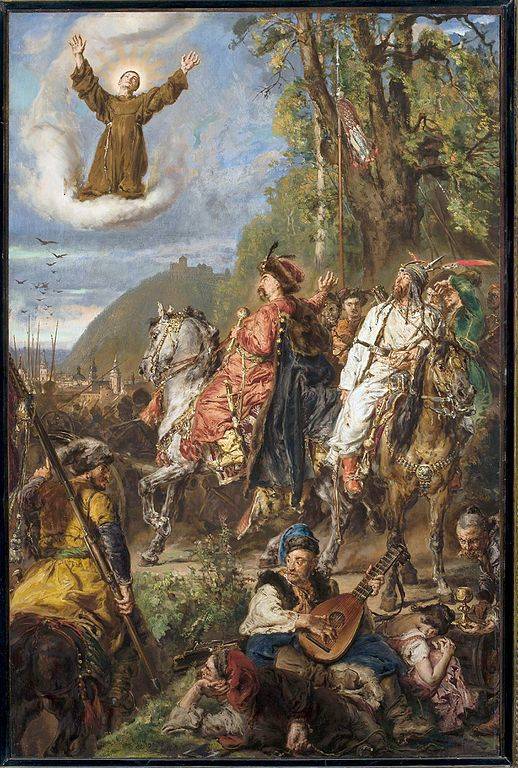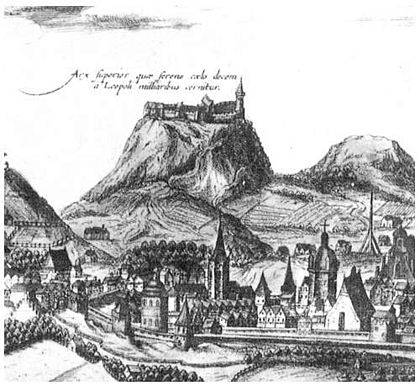“I come to you as the liberator of the Russian people!”

Khmelnitsky and Tugay Bey near Lviv. Painting by Jan Matejko (1885)
After the victory at Pylyavtsy, the Russian troops of Khmelnytsky developed an offensive against Lvov and Zamosc. Warsaw was forced to accept the armistice.
Offensive development. Siege of Lvov
After the catastrophe of the Polish army near Pilyavtsy (Pogrom of the Polish army near Pilyavtsi) the gentry ran 300 km to Lviv itself. Only the banners of Prince Vishnevetsky retreated in perfect order. The Commonwealth no longer had an army. But an invasion deep into the Commonwealth, with robbery and ruin of cities, Catholic churches and monasteries, would inevitably have caused serious resistance from the Poles.
Before Bohdan Khmelnitsky the question arose: what next? Continue the offensive, go further, or stop there, gain a foothold on the border of the Sluch River? Bogdan was an experienced warrior and commander, a competent and cunning diplomat, possessed remarkable talent and an iron will. He understood that the Dnieper region was devastated by the war, the uprising led not only to freedom, but also to devastation and hunger. And the army needs to be fed and maintained. It also needs to be equipped, arranged and prepared for new battles. Many foremen have collected a lot of good and want peace and prosperity. Return home and live like gentlemen. But there are also violent, determined chieftains, like Krivonos, Bohun, Nebaba and others, they are for the continuation of the war. The logic of the war required continuation, to prevent the enemy from recovering, to finish off.
On September 16, 1648, after the capture of Starokonstantinov, a Cossack Rada took place. The issue of continuing the offensive deep into the Commonwealth, or returning home, was being decided. Most of the Cossacks were in favor of "finishing off the Pole". On the same day, a large army of 50-70 thousand moved to Zbarazh, Zborov and Lvov. Local peasants and the urban lower classes joined the rebels in droves. When the vanguard of the peasant-Cossack army, led by Krivonos, approached Zbarazh, the local Cossacks and burghers, having killed the guards, opened the gates. With the help of the townspeople, the Bernardine monastery was also captured. A detachment of Timofey Khmelnitsky approached the city of Zborov. The townspeople went out to meet him and brought rich gifts to the hetman's son.
The Cossack detachments dispersed in corrals and began to clear the Russian land from the enemy. They passed through Volyn and Polissya. Detachments of Nebaba, Mikhnenko and Krivoshapka moved to White Rus', occupied a number of cities.
The main forces of Khmelnytsky on September 26-28, 1648 reached Lvov. The ancient Russian city was a major trading center, a junction of roads that went from Kyiv, Moldavia, the Carpathian region, Poland and the Baltic states. The owners of the city were wealthy patricians, mostly Catholics. Many merchants lived here, both Russians and Armenians, Jews, Poles, Tatars, Greeks, etc. There were many rich churches and monasteries.
Khmelnytsky, who lived in the city for many years, loved Lvov and did not want its destruction. On the way to the city, he wrote a letter to the Lviv authorities with an offer of friendship.
Red Rus' (also Red Rus', Chervona Rus'; lat. Russia Rubra) - historical region in the X-XVIII centuries; part of Rus', located in the west of modern Ukraine and the southeast of modern Poland. Also known as Galician Rus, Galicia, Red Cities. Significant cities of Chervonnaya Rus were Lvov, Zvenigorod, Galich, Terebovl, Sanok, Krosno, Belz, Zamosc and Kholm.
Bohdan's letter was not accepted by the rulers of Lvov. Here they prepared for defense. First, thousands of gentry took refuge there, who fled after the catastrophe near Pilyavtsy, led by their commanders Zaslavsky and Ostrorog. Zaslavsky, however, almost immediately fled to his fiefdom. Ostrohorn remained in the city for some time and wanted to lead its defense. But the local authorities refused to recognize his authority and called Vishnevetsky. The prince collected a huge amount from the city to protect it and departed ostensibly for the defense of Warsaw. Following him, other commanders and pans fled from the city.
Khmelnitsky did not want to storm the city, forbade burning the suburbs and robbing the townspeople. He needed a ransom to pay off Tugai Bey's Tatars. The detachment of Krivonos took the position dominating the city - the High Castle. Krivonos himself was wounded.
Bogdan again offered negotiations to the Lvov patricians. On October 11, the foremen of the city sent to Khmelnitsky his old priest teacher, the Jesuit professor Mokrsky. The Jesuit was an important person - a canon of King Vladislav, a confidant of Prince Jan-Kazimir. Bogdan greeted him warmly. He set one condition: to give a ransom. The townspeople eventually agreed to a huge payoff in the amount of 365 thousand zlotys (according to other sources - 220 thousand).

Fragment of engraving panorama of Lviv XVII century
Zamosc
Khmelnytsky's army advanced to Zamost (Zamosc), where Vyshnevetsky's troops initially stood. It was the strongest fortress in Poland. In addition, unlike others, she was prepared in advance for a long defense by Vishnevetsky himself. Artillery was strengthened, ammunition was brought in, provisions were prepared. The defense was led by Colonel Ludwig Weiher and one of the richest magnates of the Commonwealth, Vladislav Myshkovsky. The garrison numbered more than 4,5 thousand people.
The hetman did not want to besiege a strong fortress. The Cossacks did not have siege artillery. Winter was approaching, the siege could lead to the decomposition of a tired army. Diseases began in the army. The talented commander Krivonos died of the plague.
Therefore, when Bogdan's troops approached the fortress on October 27, 1648, he sent two letters: to Colonel Weiher - with an invitation to join the Cossacks and the gentry, and the townspeople of Zamostye - with a proposal to start peace negotiations. The hetman pointed out that the war was being waged through the fault of Vishnevetsky and Konetspolsky, they started the war, that the Cossacks were inclined towards peace. He offered to make peace, as the Lviv people did. The besieged, feeling safe, refused to accept peace. The besieged repulsed the first attacks of the Cossacks with strong rifle and cannon fire.
After that, the Cossacks no longer tried to attack. Moreover, cold rains began, mudslides. Diseases decimated people. Bogdan played for time, waited, again offered negotiations. Soon the besieged were tired of the war and agreed to give Khmelnytsky a ransom of 20 thousand zlotys. On November 14, 1648, the Cossack Rada decided to lift the siege and return home. In December, the Cossacks solemnly returned to Kyiv.
Elections
Simultaneously with the siege of Lvov and Zamostye, Khmelnytsky negotiated with the Poles. After a big victory, Bogdan hoped that the pans would grow wiser and make concessions. In October, a new Sejm opened in Warsaw, and a king was elected there. The hetman hoped that the Polish gentry would not be up to the Russian Ukraine for some time.
Indeed, during the election of the king in the Commonwealth, there was no time for external problems. Often disputes and electoral passions flowed into civil war, rebellions and uprisings. The prince of Transylvania Rakoczy, Vishnevetsky put forward his candidacies - but the delegates rejected him, they were afraid for his tough temper. Moscow also put forward its candidacies - they offered to choose Tsar Alexei Mikhailovich or his son Dmitry.
However, there were only two real candidates - the brothers of the late King Vladislav, Bishop Karl-Ferdinand and Jan-Kazimir. Bishop Karl-Ferdinand received the support of the Catholic clergy, many magnates of Poland and Russian Ukraine. He acted as the leader of the "party of war", for the brutal suppression of the Russian uprising. The magnates of the Grand Duchy of Lithuania, led by the Radziwill brothers, opposed Charles. They were afraid of strengthening the counter-reformation and threatened to break the Polish-Lithuanian union.
The youngest of the brothers, Jan-Kazimir, was a candidate for a "peaceful" party led by Chancellor Ossolinsky. This group stood up for the conclusion of peace with Khmelnitsky. Jan Casimir's group, of course, also wanted to crush the uprising. But after a while, since Poland did not yet have the strength. Buy time, prepare the army, calm and split the rebels with concessions, and then deliver a sudden death blow. Also, the grouping of Ossolinsky and Jan-Kazimir was afraid that Khmelnitsky, not finding a common language with Warsaw, would come to an agreement with Moscow.
Jan Casimir was a pupil of the Jesuits. The Jesuit order was, in essence, the most powerful intelligence agency of the papal throne. Long before the uprising, they soberly reported how dangerous the situation in Little Rus' was. Jan-Kazimir was prepared for the throne, even during the life of Vladislav he flirted with the petty gentry, showed himself as an opponent of the pans. Rumors spread about the coming "good king".
Jan Casimir sent his secret ambassadors to Khmelnitsky. Promised a good world. Bogdan achieved this, played along with him. He presented the Sejm with an ultimatum: if they choose Karl, the Cossacks will resume the offensive. The deputies were frightened, many were afraid for their estates. In Warsaw itself, there were many participants in the battle of Pilyavtsy, they spread panic. Grabianka described them well in his chronicle: “Many Poles gathered in Warsaw, and all of them had hare ears, Khmelnitsky overtook them with such fear that he heard the crackle of a dry tree that they fled to Gdansk without a soul and in a dream more than one shouted: “Here Khmelnitsky! This fear was used by King Yang's party. In November 1648, Jan Casimir was elected king.
At this time, a Cossack embassy headed by Zakhary Khmelnitsky (the hetman's cousin) arrived in Warsaw. The Jesuit Mokrytsky also came to the king, who concluded that now Poland could not crush the rebels. Khmelnytsky supported the candidacy of Jan-Kazimir. The terms of the truce were moderate: that there should be no union and Uniates, the preservation of Orthodoxy; a register of 12 thousand Cossacks; the Cossacks received the rights of the Lithuanian Tatars (equal to the gentry); no Polish garrisons in the Russian Ukraine; the hetman was elected by the Cossacks themselves and was under the authority of the king alone; full forgiveness to all rebels; the Cossacks had the right to go to sea whenever they wanted and in any number.
The king and the Sejm decided to conclude a truce with the Cossacks. Khmelnytsky was recognized as a hetman. In the near future, they were going to send commissars to him to present him with signs of hetman power and conduct negotiations.
Information